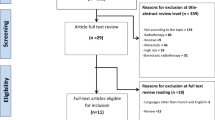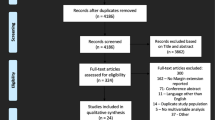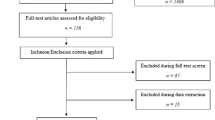Abstract
Background
Changes applied to the Prostate cancer (PCa) histopathology grading, where patients with cribriform patterns (CP) may be categorized as grade group 2 and could hypothetically be surveilled. However, CP has been associated with worse oncological outcomes. The aim of our study is to systematically review and meta-analyze the available evidence on CP in PCa patients.
Methods
This analysis was registered on PROSPERO (CRD42022298473). We performed a systematic literature search of PubMed, EMBASE and Scopus using Medical Subject Headings (MeSH) indexes, keyword searches, and publication types until December 2021. The search terms included: “prostate”, “prostate cancer” and “cribriform”. We also searched reference lists of relevant articles. Eligible studies included published journal articles that provided quantitative data on the association between cribriform patterns at radical prostatectomy and the presence of extra-prostatic extension (EPE), seminal vesicle invasion (SVI), positive surgical margins (PSM), biochemical recurrence (BCR) or cancer specific mortality (CSM).
Results
Overall, 31 studies were included for the quantitative analysis. All articles have been published during a span of 11 years (2011–2022) with a mean month of follow-up of 62.87 months. The mean quality of these studies, assessed with the Newcastle Ottawa Scale was 6.27. We demonstrated that CP was associated with greater risk of EPE (odds ratio [OR] 1.96; P < 0.0001), SVI (OR: 2.89; p < 0.01), and PSM (OR: 1.88; p < 0.0007). Our analyses showed that CP was associated with greater risk of BCR (hazard ratio [HR]: 2.14; p < 0.01) and of CSM (HR: 3.30, p < 0.01).
Conclusion
The presence of CP is associated with adverse pathology at radical prostatectomy and worse biochemical recurrence and cancer specific mortality. These results highlight the importance of a better pathologic report of CP to advise clinician for a strict follow-up in PCa patients.
This is a preview of subscription content, access via your institution
Access options
Subscribe to this journal
Receive 4 print issues and online access
$259.00 per year
only $64.75 per issue
Buy this article
- Purchase on Springer Link
- Instant access to full article PDF
Prices may be subject to local taxes which are calculated during checkout






Similar content being viewed by others
References
Bailar J, Mellinger GT, Gleason DF. Survival rates of patients with prostatic cancer, tumor stage, and differentiation—preliminary report. Cancer Chemother Rep. 1966;50:129–36.
Epstein JI, Allsbrook WC, Amin MB, Egevad LL, Bastacky S, López Beltrán A, et al. The 2005 International Society of Urological Pathology (ISUP) Consensus Conference on Gleason Grading of Prostatic Carcinoma. Am J Surg Pathol. 2005;29:1228–42.
Epstein JI, Amin MB, Reuter VE, Humphrey PA. Contemporary gleason grading of prostatic carcinoma an update with discussion on practical issues to implement the 2014 international society of urological pathology (ISUP) consensus conference on gleason grading of prostatic carcinoma. Am J Surg Pathol. 2017;41:e1–7.
Kir G, Sarbay BC, Gumus E, Topal CS. The association of the cribriform pattern with outcome for prostatic adenocarcinomas. Pathol Res Pr. 2014;210:640–4.
Trudel D, Downes MR, Sykes J, Kron KJ, Trachtenberg J, Van Der Kwast TH. Prognostic impact of intraductal carcinoma and large cribriform carcinoma architecture after prostatectomy in a contemporary cohort. Eur J Cancer. 2014;50:1610–6.
Kweldam CF, Wildhagen MF, Steyerberg EW, Bangma CH, van der Kwast TH, van Leenders GJLH. Cribriform growth is highly predictive for postoperative metastasis and disease-specific death in Gleason score 7 prostate cancer. Mod Pathol. 2015;28:457–64.
Böker A, Kuczyk MA, Kramer MW, Merseburger AS, Krüger K, Imkamp F, et al. True incidence of gleason 6 pathology in patients with metastatic castration resistant prostate cancer (mCRPC). Adv Ther. 2017;34:171–9.
De Nunzio C, Pastore AL, Lombardo R, Simone G, Leonardo C, Mastroianni R et al. The new Epstein gleason score classification significantly reduces upgrading in prostate cancer patients. Eur J Surg Oncol. 2018. https://doi.org/10.1016/j.ejso.2017.12.003.
Brassetti A, Lombardo R, Emiliozzi P, Cardi A, Antonio DV, Antonio I et al. Prostate-specific antigen density is a good predictor of upstaging and upgrading, according to the new grading system: the keys we are seeking may be already in our pocket. Urology. 2018. ihttps://doi.org/10.1016/j.urology.2017.07.071.
Awasthi S, Mahal BA, Park JY, Creed JH, Williams VL, Elkenawi A et al. Substantial Gleason reclassification in Black men with national comprehensive cancer network low-risk prostate cancer - A propensity score analysis. Prostate Cancer Prostatic Dis. 2022. https://doi.org/10.1038/S41391-022-00510-Z.
Page MJ, McKenzie JE, Bossuyt PM, Boutron I, Hoffmann TC, Mulrow CD, et al. The PRISMA 2020 statement: An updated guideline for reporting systematic reviews. PLOS Med. 2021;18:e1003583.
Wells GA, Shea B, O’Connell D, Peterson J, Welch V, Losos M, et al. The Newcastle-Ottawa Scale (NOS) for assessing the quality if nonrandomized studies in meta-analyses. http://www.ohri.ca/programs/clinical_epidemiology/oxford.htm 2022.
Au S, Villamil CF, Alaghehbandan R, Wang G. Prostatic ductal adenocarcinoma with cribriform architecture has worse prognostic features than non-cribriform-type. Ann Diagn Pathol. 2019;39:59–62.
Elfandy H, Armenia J, Pederzoli F, Pullman E, Pertega-Gomes N, Schultz N, et al. Genetic and epigenetic determinants of aggressiveness in cribriform carcinoma of the prostate. Mol Cancer Res. 2019;17:446–56.
Hollemans E, Verhoef EI, Bangma CH, Rietbergen J, Helleman J, Roobol MJ, et al. Large cribriform growth pattern identifies ISUP grade 2 prostate cancer at high risk for recurrence and metastasis. Mod Pathol. 2019;32:139–46.
Hollemans E, Verhoef EI, Bangma CH, Schoots I, Rietbergen J, Helleman J, et al. Concordance of cribriform architecture in matched prostate cancer biopsy and radical prostatectomy specimens. Histopathology. 2019;75:338–45.
Luo X, Khurana JS, Jhala N, Zhao H, Wang H. The association of invasive cribriform lesions with adverse prostatic adenocarcinoma outcomes: an institutional experience, systematic review, and meta-analysis. Arch Pathol Lab Med. 2019;143:1012–21.
Bernardino RM, Carvalho R, Severo L, Alves M, Papoila AL, Pinheiro LC. Prostate cancer with cribriform pattern: Exclusion criterion for active surveillance? Arch Ital DI Urol E Androl. 2020;92:235–8.
Flammia S, Frisenda M, Maggi M, Magliocca FM, Ciardi A, Panebianco V, et al. Cribriform pattern does not have a significant impact in Gleason Score ≥7/ISUP Grade ≥2 prostate cancers submitted to radical prostatectomy. Med (Baltim). 2020;99:e22156.
Gao J, Zhang Q, Fu Y, Wang W, Zhang C, Kan Y, et al. Combined clinical characteristics and multiparametric MRI parameters for prediction of cribriform morphology in intermediate-risk prostate cancer patients. Urol Oncol Semin Orig Investig. 2020;38:216–24.
Greenland NY, Cowan JE, Zhang L, Carroll PR, Chan E, Stohr BA, et al. Expansile cribriform Gleason pattern 4 has histopathologic and molecular features of aggressiveness and greater risk of biochemical failure compared to glomerulation Gleason pattern 4. Prostate. 2020;80:653–9.
Haffner MC, Salles DC, Gao G, Epstein JI. Gleason pattern 4 with cribriform morphology on biopsy is associated with adverse clinicopathological findings in a prospective radical prostatectomy cohort. Hum Pathol. 2020;98:74–80.
Spieker AJ, Gordetsky JB, Maris AS, Dehan LM, Denney JE, Arnold Egloff SA, et al. PTEN expression and morphological patterns in prostatic adenocarcinoma. Histopathology. 2021;79:1061–71.
Hollemans E, Verhoef EI, Bangma CH, Rietbergen J, Helleman J, Roobol MJ, et al. Prostate carcinoma grade and length but not cribriform architecture at positive surgical margins are predictive for biochemical recurrence after radical prostatectomy. Am J Surg Pathol. 2020;44:191–7.
Czaja RC, Tarima S, Wu R, Palagnmonthip W, Iczkowski KA. Comparative influence of cribriform growth and percent Gleason 4 in prostatic biopsies with Gleason 3+4 cancer. Ann Diagn Pathol. 2021;52:151725.
da Paz AR, Billis A, Freitas LLL, Costa LBE, Barreto IS, Magna LA, et al. Prognostic significance of architectural subtypes of Gleason grade 4 prostate cancer in radical prostatectomy: A semiquantitative method of evaluation. Ann Diagn Pathol. 2021;50:151678.
Hansum T, Hollemans E, Verhoef EI, Bangma CH, Rietbergen J, Osanto S, et al. Comedonecrosis Gleason pattern 5 is associated with worse clinical outcome in operated prostate cancer patients. Mod Pathol. 2021;34:2064–70.
Hollemans E, Verhoef EI, Bangma CH, Rietbergen J, Osanto S, Pelger RCM, et al. Cribriform architecture in radical prostatectomies predicts oncological outcome in Gleason score 8 prostate cancer patients. Mod Pathol. 2021;34:184–93.
Kryvenko ON, Iakymenko OA, De Lima Guido LP, Bhattu AS, Merhe A, Mouzannar A et al. Prostatic ductal adenocarcinoma controlled for tumor grade, stage, and margin status does not independently influence the likelihood of biochemical recurrence in localized prostate cancer after radical prostatectomy. Arch Pathol Lab Med. 2021. https://doi.org/10.5858/arpa.2021-0048-OA.
Ma C, Downes M, Jain R, Ientilucci M, Fleshner N, Perlis N, et al. Prevalence of adverse pathology features in grade group 2 prostatectomy specimens with syn‐ or metachronous metastatic disease. Prostate. 2022;82:345–51.
Seyrek N, Hollemans E, Osanto S, Pelger RCM, Poel HG, Bekers E, et al. Cribriform architecture outperforms Gleason pattern 4 percentage and tertiary Gleason pattern 5 in predicting the outcome of Grade Group 2 prostate cancer patients. Histopathology. 2022;80:558–65.
Dong F, Yang P, Wang C, Wu S, Xiao Y, McDougal WS, et al. Architectural heterogeneity and cribriform pattern predict adverse clinical outcome for Gleason grade 4 prostatic adenocarcinoma. Am J Surg Pathol. 2013;37:1855–61.
Sarbay BC, Kir G, Topal CS, Gumus E. Significance of the cribriform pattern in prostatic adenocarcinomas. Pathol - Res Pr. 2014;210:554–7.
Bernardino RM, Carvalho R, Severo L, Alves M, Papoila AL, Pinheiro LC. Prostate cancer with cribriform pattern: Exclusion criterion for active surveillance? Arch Ital di Urol e Androl. 2020;92. https://doi.org/10.4081/aiua.2020.3.235.
Chua MLK, Lo W, Pintilie M, Murgic J, Lalonde E, Bhandari V, et al. A prostate cancer ‘nimbosus’: genomic instability and SChLAP1 dysregulation underpin aggression of intraductal and cribriform subpathologies. Eur Urol. 2017;72:665–74.
van der Kwast TH, van Leenders GJ, Berney DM, Delahunt B, Evans AJ, Iczkowski KA, et al. ISUP consensus definition of cribriform pattern prostate cancer. Am J Surg Pathol. 2021;45:1118–26.
Luo X, Khuran JS, Jhal N, Zhao OAQ, Wang H. The association of invasive cribriform lesions with adverse prostatic adenocarcinoma outcomes an institutional experience, systematic review, and meta-analysis. Arch Pathol Lab Med. 2019;143:1012–21.
Taylor AS, Morgan TM, Wallington DG, Chinnaiyan AM, Spratt DE, Mehra R. Correlation between cribriform/intraductal prostatic adenocarcinoma and percent Gleason pattern 4 to a 22-gene genomic classifier. Prostate. 2020;80:146–52.
Böttcher R, Kweldam CF, Livingstone J, Lalonde E, Yamaguchi TN, Huang V et al. Cribriform and intraductal prostate cancer are associated with increased genomic instability and distinct genomic alterations. BMC Cancer. 2018;18. https://doi.org/10.1186/s12885-017-3976-z.
Gordetsky JB, Schaffer K, Hurley PJ. Current conundrums with cribriform prostate cancer. Histopathology. 2022;80:1038–40.
Ericson KJ, Wu SS, Lundy SD, Thomas LJ, Klein EA, McKenney JK. Diagnostic accuracy of prostate biopsy for detecting cribriform gleason pattern 4 carcinoma and intraductal carcinoma in paired radical prostatectomy specimens: implications for active surveillance. J Urol. 2020;203:311–9.
Masoomian M, Downes MR, Sweet J, Cheung C, Evans AJ, Fleshner N, et al. Concordance of biopsy and prostatectomy diagnosis of intraductal and cribriform carcinoma in a prospectively collected data set. Histopathology. 2019;74:474–82.
Mottet N, van den Bergh RCN, Briers E, Van den Broeck T, Cumberbatch MG, De Santis M, et al. EAU-EANM-ESTRO-ESUR-SIOG guidelines on prostate cancer—2020 update. Part 1: screening, diagnosis, and local treatment with curative intent. Eur Urol. 2021;79:243–62.
van Leenders GJLH, van der Kwast TH, Grignon DJ, Evans AJ, Kristiansen G, Kweldam CF, et al. The 2019 international society of urological pathology (ISUP) consensus conference on grading of prostatic carcinoma. Am J Surg Pathol. 2020;44:e87–e99.
Numbere N, Teramoto Y, Gurung PMS, Wang Y, Yang Z, Miyamoto H. The clinical impact of unilateral versus bilateral invasion into the seminal vesicle in patients with prostate cancer undergoing radical prostatectomy. Arch Pathol Lab Med. 2021. https://doi.org/10.5858/arpa.2021-0265-OA.
Truong M, Feng C, Hollenberg G, Weinberg E, Messing EM, Miyamoto H, et al. A comprehensive analysis of cribriform morphology on magnetic resonance imaging/ultrasound fusion biopsy correlated with radical prostatectomy specimens. J Urol. 2018;199:106–13.
Choy B, Pearce SM, Anderson BB, Shalhav AL, Zagaja G, Eggener SE, et al. Prognostic significance of percentage and architectural types of contemporary gleason pattern 4 prostate cancer in radical prostatectomy. Am J Surg Pathol. 2016;40:1400–6.
Keefe DT, Schieda N, El Hallani S, Breau RH, Morash C, Robertson SJ, et al. Cribriform morphology predicts upstaging after radical prostatectomy in patients with Gleason score 3 + 4 = 7 prostate cancer at transrectal ultrasound (TRUS)-guided needle biopsy. Virchows Arch. 2015;467:437–42.
Iczkowski KA, Torkko KC, Kotnis GR, Storey Wilson R, Huang W, Wheeler TM, et al. Digital quantification of five high-grade prostate cancer patterns, including the cribriform pattern, and their association with adverse outcome. Am J Clin Pathol. 2011;136:98–107.
Author information
Authors and Affiliations
Consortia
Contributions
Conceptualization: GIR; methodology: GIR, TS, IPS, GG; formal analysis: GIR; data curation: GIR, TS, IPS, GG; writing—original draft preparation: GIR, TS, IPS, GG; writing—review and editing, all authors; supervision, all authors. All authors have read and agreed to the published version of the manuscript.
Corresponding author
Ethics declarations
Competing interests
The authors declare no competing interests.
Additional information
Publisher’s note Springer Nature remains neutral with regard to jurisdictional claims in published maps and institutional affiliations.
Rights and permissions
Springer Nature or its licensor holds exclusive rights to this article under a publishing agreement with the author(s) or other rightsholder(s); author self-archiving of the accepted manuscript version of this article is solely governed by the terms of such publishing agreement and applicable law.
About this article
Cite this article
Russo, G.I., Soeterik, T., Puche-Sanz, I. et al. Oncological outcomes of cribriform histology pattern in prostate cancer patients: a systematic review and meta-analysis. Prostate Cancer Prostatic Dis 26, 646–654 (2023). https://doi.org/10.1038/s41391-022-00600-y
Received:
Revised:
Accepted:
Published:
Issue Date:
DOI: https://doi.org/10.1038/s41391-022-00600-y
This article is cited by
-
MDT perspective: intraductal carcinoma of the prostate: implication for diagnosis and treatment
Prostate Cancer and Prostatic Diseases (2024)
-
Does prostate cancer without cribriform pattern have metastatic potential?
Prostate Cancer and Prostatic Diseases (2024)
-
High GLUT1 membrane expression and low PSMA membrane expression in Ductal Adenocarcinoma and Intraductal Carcinoma of the prostate
Prostate Cancer and Prostatic Diseases (2023)



